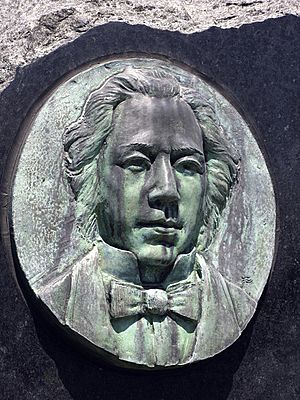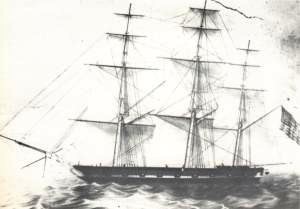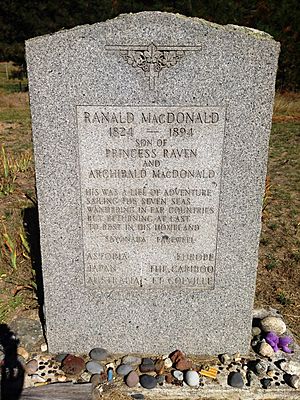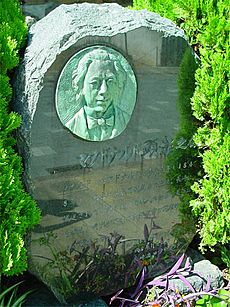Ranald MacDonald facts for kids
Quick facts for kids
Ranald MacDonald
|
|
|---|---|

|
|
| Born | February 3, 1824 |
| Died | August 24, 1894 (aged 70) Washington, USA
|
| Resting place | Ranald McDonald Cemetery, Ferry County, Washington, USA |
| Other names | Referred to in his father's letters as Toole or Toole-Toole, supposedly from a Chinook word for 'bird'. |
| Known for | Visiting Japan before Commodore Perry's 'opening of Japan' and teaching English to Japanese interpreters. |
| Parent(s) | Archibald McDonald Princess Raven/Princess Sunday Jane Klyne McDonald (stepmother) |
| Relatives | Chief Comcomly |
Ranald MacDonald (born February 3, 1824, died August 24, 1894) was a brave adventurer. He was the very first person from an English-speaking country to teach English in Japan. One of his students, Einosuke Moriyama, became a key interpreter. He helped with important talks between Commodore Perry and the Japanese government.
Contents
Ranald's Early Life and Family
Ranald MacDonald was born at Fort Astoria. This fort was in the Pacific Northwest of North America. At that time, the area was called the Columbia District. It was a disputed land, meaning both the British and Americans claimed it.
Ranald's father was Archibald McDonald. He was a Scottish fur trader for the Hudson's Bay Company. His mother was Koale'xoa, also known as Raven or Princess Sunday. She was a Chinook woman. Her father was Comcomly, a leader of the Chinook people. Ranald was part of the larger Métis community. Métis people have both Indigenous and European ancestors.
Some stories say that Ranald met three shipwrecked Japanese sailors when he was eight. This was supposed to happen at Fort Vancouver. But this meeting never actually took place. Ranald had already left the fort before the sailors arrived.
Ranald always wanted to learn about other cultures. He wrote in his autobiography: "My plan was to present myself as a castaway... My purpose was to learn of them; and, if occasion should offer, to instruct them of us."
Ranald went to school at the Red River Academy. This school was in the Red River Colony, which is now Manitoba, Canada. After school, he worked as a bank clerk. This was what his father wanted him to do.
Journey to Japan

Ranald was a restless person. He soon left his bank job. He decided he wanted to visit Japan. At that time, Japan had a very strict policy called sakoku. This meant foreigners were not allowed to enter the country. If they did, they could be killed or put in prison.
In 1845, Ranald joined a whaling ship called the Plymouth. In 1848, he convinced the captain to let him go ashore in a small boat. This was off the coast of Hokkaidō, Japan. On July 1, he landed on Rishiri Island. He pretended he had been shipwrecked.
Local Ainu people found him. They sent him to the local leader, called a daimyō. From there, Ranald was sent to Nagasaki. This was the only port in Japan where limited trade with the Dutch was allowed.
Teaching English in Japan
Japan was seeing more and more American and British ships. But no one in Japan spoke English well. So, fourteen men were chosen to study English with Ranald. These men were samurai. They had already learned Dutch. They had been trying to learn English from Dutch merchants.
The smartest of these students was Moriyama Einosuke. He was very good at languages. Ranald was kept in a temple called Daihian in Nagasaki. He stayed there for 10 months. During this time, he also learned Japanese.
In April 1849, Ranald and fifteen other shipwrecked sailors were rescued. They were taken aboard an American warship called the USS Preble. Captain James Glynn was in charge of the ship. After this, Captain Glynn suggested that the United States should make a treaty with Japan. He even said they should use force if needed.
Life After Japan
After returning to North America, Ranald wrote a report for the US Congress. He explained that Japanese society was well-organized. He also said the Japanese people were well-behaved and of high standards. He continued his life as a sailor.
Ranald traveled widely. In 1858, he went to the new colony of British Columbia in Canada. He started a business in the Fraser River gold fields. Later, he worked in the Cariboo in 1864. He also took part in an exploration trip called the Vancouver Island Exploring Expedition.
Even though his students helped open Japan to the world, Ranald did not get much recognition. His notes about his adventures in Japan were not published until 1923. This was 29 years after he died. Ranald died in Washington state in 1894. He was visiting his niece and was not a rich man. His last words were said to be "Sayonara, my dear, sayonara..."
Memorials and Burial Place
Ranald MacDonald is buried in the Ranald MacDonald Cemetery. This cemetery is in Ferry County, Washington. His grave marker has a special message:
RANALD MacDONALD 1824–1894
SON OF PRINCESS RAVEN AND ARCHIBALD MacDONALD
HIS WAS A LIFE OF ADVENTURE SAILING THE SEVEN SEAS
WANDERING IN FAR COUNTRIES BUT RETURNING AT LAST TO REST IN HIS HOMELAND. SAYONARA – FAREWELL
ASTORIA EUROPE JAPAN THE CARIBOO AUSTRALIA FT COLVILLE
There are also memorials for Ranald MacDonald in other places. You can find them on Rishiri Island and in Nagasaki, Japan. There is also one in his birthplace, where Fort Astoria used to stand in Astoria, Oregon.




